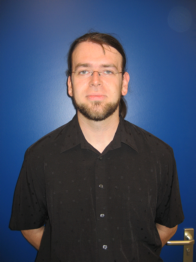Ab initio study of Pt induced nanowires on Ge(001)
Promotion date: 11. September 2009
Promotor: Prof. Dr. Paul Kelly
Assistant Promotor: Dr. Geert Brocks
| In 2003 self-assembled nanowire arrays were observed, equally spaced at 1,6 nm, virtually defect and kink free, and only a single atom wide while being hundreds of nanometers long. The dubbed Pt-nanowires, turned out not to be conductive. Instead the regions between the nanowires showed conductive behaviour. In this thesis, this NW-system was studied using ab-initio density functional theory (DFT) calculations in combination with calculated scanning tunnelling microscopy images. Comparison to experimental images allowed to identify the geometry of the β-terrace geometry. From this, scenarios for nanowire formation were proposed. The spontaneous transformation from the widened trough to a Ge-nanowire is energetically very favourable. Calculated STM images show perfect agreement with the experimentally observed nanowires. This means that the experimentally observed `Pt nanowires` are composed of germanium atoms, explaining the unexpected lack of conductivity on the wires. |
The outcome of your work is somewhat surprising to some ...
Experimentalists saw something different from what they expected. This is explained by the specific binding of platinum atoms in the substrate to the germanium dimers. It is the germanium atoms, actually forming the nanowires under investigation.
CO molecules which bind to the Pt atoms - lining the trough while the germanium nanowire stays slightly above it - tilt toward the nanowire, giving rise to STM images of the molecule `on´ the wire. This theoretical explanation was somewhat surprising because the idea is very contra-intuitive. They told me many times to take a close look at the STM images, all over again.
Are you still convinced?
Already in an early stage I was sure that the conductivity was caused by the Pt atoms in the substrate and that the wire consisted of germanium. You have to know what to look for, in the seemingly useless pile of data presented to you.
The experimentalists did a wonderful job. The resolutions they obtained were in some cases even better than they expected themselves. In one case, I could identify some d-orbitals that were clearly visible. Again, if you know what you could expect in this kind of images, things become easier to recognize.
So, as a theoretical oriented scientist, you had to work closely together with the
experimentalists?
In this type of research, such is inevitable. As a theorist you always want to live in an ideal world, placing atoms in exact configurations and making calculations out of them. The experimental results are important, to choose between the scenarios derived from theoretical, controlled, calculations and simulations.
Experimentalists and theorists try to find each other. As a theorist I try to calculate bigger systems, containing more than one hundred atoms, for example. Experimentalists succeed in looking at smaller systems, again and again. One of my propositions is very clear about that. Good calculations are computationally expensive. A calculation at half the price can quickly become totally useless.
In my opinion the differences are not so big at all. Of course, an experimentalist needs more practical skills than someone who is more of a theorist. On the other hand, both share the same scientific mentality, I am convinced.
What are your future plans?
In November I am starting at the university of Gent, to work on a project that will be in some sense similar to my work here at Mesa+, only in a different field of research, namely superconductivity.

